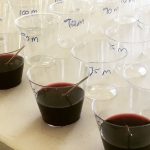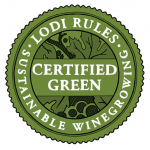Wine Blend Spotlight: Mettler Ranch GSM
A beautiful blend of three Rhone varietals: Grenache, Syrah, Mourvedre. All three of these varietals trace back to the Mediterranean coast and thrive in the Lodi climate. They blend poetically together, each bringing a different flavor profile. Grenache adds a fresh raspberry flavor. The Syrah brings savory dark fruit flavors and a velvety mouth-feel. Mourvedre adds a nice tannin structure and herbaceous aromas. A delicious wine to try!

You can ferment it a number of ways. You can do what is called a “field blend” and blend everything at crush. Or you ferment each varietal seperately. Either way makes a great wine. It all comes down to the equipment you have and the amount of time you have. If you don’t have a lot of storage vessels then doing a field blend is the way to go.
Field Blend Fermentation:
- Crushing and Fermenting: After harvesting, co-ferment the grapes together in the same fermentation vessel. This means that the Grenache, Syrah, and Mourvèdre grapes are all mixed together from the start. The co-fermentation process allows for the blending of flavors and characteristics at the earliest stage.
- Temperature Control: Control the fermentation temperature carefully, as each grape variety may have different requirements. Find a temperature that works well for all three varieties to ensure proper extraction of flavors and tannins.
- Taste and Adjust: Monitor the fermentation process and taste the wine to assess the development of flavors. Make any necessary adjustments, such as adding yeast or adjusting the temperature, to achieve the desired characteristics.
- Aging: After fermentation, age the wine in suitable containers, such as oak barrels or stainless steel tanks. Aging allows the flavors to meld and develop complexity.
- Bottling: Once the wine has aged to your satisfaction, bottle it. Label the bottles with the vintage and the type of field blend GSM.
- Enjoy: Once the wine has aged to your satisfaction, bottle it. Label the bottles with the vintage and the type of field blend GSM.
Creating a field blend GSM wine is a unique approach that requires careful planning and execution in the vineyard. It can result in a wine with distinctive characteristics that reflect the terroir and the synergy of the three grape varieties grown together.
Fermenting the Grapes Seperately:
- Fermentation: Fermenting each grape variety separately helps control the extraction and balance of flavors. Add yeast to start the fermentation process. Pro Tip: Use different yeasts for each batch and you will create even more complexity!
- Temperature: Monitor and control the fermentation temperature. Grenache, for example, generally benefits from higher fermentation temperatures, while Syrah and Mourvèdre might require lower temperatures to preserve their desired characteristics.
- Taste and Analyze: Taste the wines from each varietal to understand their individual characteristics. Analyze factors such as aroma, flavor, acidity, tannin, and alcohol content.
- Blending Trials: Once each wine has completed fermentation and has been aged to your liking, start experimenting with different blends. This is where the art of blending comes into play. Start with small trial blends and make adjustments to the ratios until you achieve the desired flavor profile and balance.
- Age the Blend: Blend the wines together and allow the blend to age in a suitable container, such as oak barrels or stainless steel tanks. The aging process helps the different components integrate and develop complex flavors. *For more information on againg your wines, check out this blog post
- Regular Tasting: Blend the wines together and allow the blend to age. The aging process helps the different components integrate and develop complex flavors.
- Bottle: Once you’re satisfied with the blend and the wine has aged to your liking, bottle it. Make sure to label the bottles appropriately, indicating the vintage and the blend.
- Enjoy: Allow the bottled wine to rest for a period before opening and enjoying. GSM blends often benefit from some additional bottle aging to reach their full potential.
GSM blends are known for their bold, rich, and complex flavor profiles, often characterized by red fruit, spice, and earthy notes. The proportions of each grape variety in the blend can vary, but Grenache is typically the dominant grape, with Syrah adding structure and Mourvèdre contributing depth and complexity. Experiment with different proportions to create your own unique GSM wine blend.
The Mettler Ranch wine grapes are available for purchase every Fall Season. If you are interested in the Mettler grapes we suggest making a pre-order by mid-August. For more information on the Mettler Ranch click here.
We’re here to help when you need it
Musto Wine Grape offers a variety of products as well as services including testing and support. Email sales@juicegrape.com or call (877) 812 – 1137 to speak with someone who can assist you.
Lodi Rules: Grow great grapes, make delicious wine, leave everything a little better than we found it
“May we farm in a way that meets the needs of today without compromising the ability of future generations to create their livelihoods.” – The LODI RULES motto.
Started in 2005, the LODI RULES certification program is a collective of growers who are focused on all thing’s sustainability. Many of these Lodi Farmers are 4th or 5th generation winegrowers who are focused on farming with the next 100 years in mind. We at Musto Wine Grape, are lucky enough to work with some of these amazing farmers – Mettler Ranch and Costamagna Vineyards. Look for the LODI RULES seal on the wine grape boxes this season.
LODI RULES growers use a unique risk model to quantify the environmental and human impact of all pesticides applied in the vineyard. This model considers the dietary risks to consumers, as well as the acute risk to farm workers; small aquatic invertebrates; birds; and bees; and bees and beneficial insects. The Lodi region has documented a great decline in the use of high-risk pesticides since 1992, thanks to sustainability adaption by farmers.
LODI RULES Sustainability Standards Overview:
- Water: They carefully manage the quality and efficiency of their water, appreciating every drop
- Soil: They do their part to make sure that soil – the foundation of the vineyard- thrives for generations to come
- Community: They support the neighborhoods and schools around the farms
- Ecosystem: They encourage biodiversity and act as stewards of the land
- Pest Management: They us an integrated approach to pest management, which includes protecting beneficial insects and minimizing risks to birds, bees, water, and people
- People: They make sure that their vineyards are a safe and rewarding place to work
- Quality: They design farming practices to improve wine grape quality
- Generational Farming: They farm with the next 100 years in mind
How is certified sustainable farming different than organic and biodynamic?
- Organic and biodynamic farmers follow a set of practices related to the environment. Certified sustainable farming includes practices related to the environment, the people, and the business.
LODI RULES has over 100 sustainable practices included in its certification; with over 28,776 acres certified.
Over 150 wines bear the LR seal (Mettler Ranch & Costamagna being some of them!) A wine must contain 85% certified grapes to be the LR seal.
“Sustainability means leaving everything – people, places, etc.- as good as better than how we found it” – Kevin Philips, Michael David Winery
“When you drink a glass of wine made from LODI RULES certified grapes, you are supporting a farmer, a vintner, and an entire agricultural community that embraces their responsibility to care for the environment and the people”
This is a certification I think we can all get behind. Musto Wine Grape is grateful to be bringing in these grapes this season. If you are interested in grapes from the LODI RULES program, please give us a call at 877-812-1137 to pre-order. We are looking forward to assisting with your winemaking this fall!
Grapes Available from LODI RULES Certified Vineyards:
Mettler Ranch:
- Barbera
- Cabernet Sauvignon
- Grenache
- Merlot
- Pinot Grigio
- Pinotage
- Petite Sirah
- Rousanne
- Sangivoese
- Syrah
- Viognier
- Zinfandel
Costamagna Vineyards:
- Old Vine Primitivo
- Cabernet
- Merlot
- Sangiovese
- Barbera
- Aglianico
- Montelpulciano
- Mourvedre
- Nero D’Avola
- Sagrantino
Cheers,
Christina Musto-Quick








Recent Comments